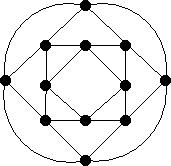
|

|

|

|
| Graph | 
| 
| 
| |||
| Line Graph | 
| 
| 
| |||
| Kite | Bowtie | Dumbell |

Consider an edge e = xy of an r regular graph G.
The edge is incident on r - 1 edges at x and r - 1
edges at y.
This gives 2(r-1) edges incident with e in G.
Given an edge of G (vertex of L(G)),
vi, then vi is adjacent to
vi-1 and vi+1 in G.
(arithmetic modulo k)
If two edges in G are incident in G, this would close the cycle
in L(G).
Thus going around the cycle in L(G) gives a cycle in G.
Let u, v and w be distinct vertices of a 5-connected
graph, G.
Since G is 5-connected, there are at least 5 internally disjoint
uv-paths.
At most one of these paths go through w.
The remaining 4 paths form 2 cycles which have only the points u and
v in common and do not go through w.

Show that a graph is 2-edge connected if and only if there is a uv-necklace for every pair of vertices u and v.
(⇒)
Let G be a 2-edge connected graph and let u and v be any pair of vertices in V(G).
Now by Menger's Theorem (edge version) there are at least two edge disjoint
uv-paths, P and Q.
Each time P and Q share a point they create a cycle.
Sharing many points creates a necklace.
(⇐)
Let G be a graph for which every pair of vertices u and v
is joined by a uv-necklace.
This means that every pair of points is joined by 2 edge disjoint paths
and so G is 2-edge connected by Mengers Theorem (edge version).
Peter Danziger, March 2008